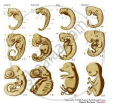Advertisements
Advertisements
प्रश्न
Enlist the evidences of evolution.
उत्तर
Following are the evidences of evolution:
- Morphological evidences
- Anatomical evidences
- Vestigial organs
- Palaeontological evidences
- Connecting links
- Embryological evidences
APPEARS IN
संबंधित प्रश्न
What are vestigial organs?
Which one of the following pairs of vegetables is an example of homologous structures?
(A) Potato and sweet potato
(B) Carrot and radish
(C) Carrot and tomato
(D) Tomato and radish
Can the wing of a butterfly and the wing of a bat be considered homologous organs? Why or why not?
Explain the terms analogous and homologous organs with examples.
Explain the evolution of giraffe's neck according to Lamarck's theory of evolution.
The presence of which of the following types of organs in two organisms indicates that they are derived from the same ancestor?
(a) analogous organs
(b) respiratory organs
(c) digestive organs
(d) homologous organs
There are five animals A, B, C, D and E. The animal A uses its modified forelimbs for flying. The animal B uses its forelimbs for running whereas the animal C uses its forelimbs for grasping. The animal D can live on land as well as in water and uses its forelimbs to prop up the front end of its body when at rest. The animal E which respires by using spiracles and tracheae uses wings for flying but its wings are analogous to the modified forelimbs of animal A.
(a) What could the animals A, B, C, D and E be?
(b) Why are the forelimbs of animals A, B, C, D called homologous organs?
(c) What does the existence of homologous organs in animals A, B, C and D tell us about their ancestors ?
(d) Why are the modified forelimbs of animal A and the wings of animal E called analogous organs?
(e) State whether animals A and E have a common ancestor or not.
In a class, students were asked to observe the models/slides/pictures of the skeletons of forelimbs and wings of different organisms. After the observations the students made the following groups of homologous structures. Select the correct group :
(A) Wings of a bird and a butterfly
(B) Wings of a pigeon and a bat
(C) Wings of a butterfly and a bat
(D) Forelimbs of a cow, a duck and a lizard
What do we call the degenerated or partially developed useless organs in living organisms? Enlist such organs in human body? How the same organs are useful in other animals?
Observe the picture and answer the following questions.
A) Which evidence of evolution is shown in the picture?
B) What can be proven with this proof?
C) Give one more example of evidence of evolution
_______ is a connecting link between Annelida and Arthropoda.
The most common types of fossils are ------------------------.
Draw a labelled diagram of T.S. of a leaf showing Kranz anatomy.
What do you mean by vestigial structures? Name four vestigial organs found in man.
Choose the correct option of the following question:
Wings of Insect and Birds are examples of :
Answer the following question:
What are homologous structures? Give an example. Is it necessary that homologous structures always have a common ancestor? Justify your answer.
Find an odd one out.
I am a connecting link between reptiles and mammals. Who am I?
Give scientific reason.
Vertebrates have slowly originated from invertebrates.
Write a short note:
Embryological evidences
Complete the flowchart.

Observe the given images and answer the following questions.

- Which evolutionary evidence does it indicate?
- What does it prove?
- State another example of evolutionary evidence.
Explain any five types of evidence that support the theory of evolution.
The degenerated and non-functional organs found in an organism are called ______.
Select vestigial organs from the following.
Select the correct statement.
Select the CORRECT match.
Which of these is not a vestigial organ in human beings?
The fossil remains of Archaeopteryx is a connecting link between ______
- Define vestigial organs.
- Write names of any two vestigial organs in the human body.
- Write name of those animals in which these vestigial organs are functional.
Homologous organs are:
Basic principles of embryonic development were pronounced by:
Evolutionary convergence is the development of:
Which is not a vestigial organ in a man?
How do we compute the age of a living tree?
Define the term:
Homologous organs
